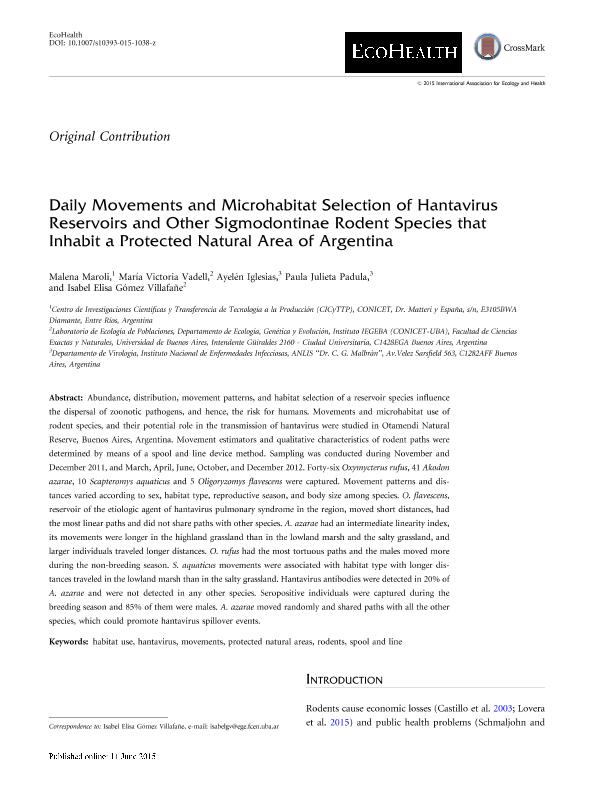Mostrar el registro sencillo del ítem
dc.contributor.author
Maroli, Malena

dc.contributor.author
Vadell, María Victoria

dc.contributor.author
Iglesias, Ayelén Aluminé

dc.contributor.author
Padula, Paula Julieta

dc.contributor.author
Gomez Villafañe, Isabel Elisa

dc.date.available
2019-04-22T16:07:41Z
dc.date.issued
2015-06
dc.identifier.citation
Maroli, Malena; Vadell, María Victoria; Iglesias, Ayelén Aluminé; Padula, Paula Julieta; Gomez Villafañe, Isabel Elisa; Daily Movements and Microhabitat Selection of Hantavirus Reservoirs and Other Sigmodontinae Rodent Species that Inhabit a Protected Natural Area of Argentina; Springer; Ecohealth; 12; 3; 6-2015; 421-431
dc.identifier.issn
1612-9202
dc.identifier.uri
http://hdl.handle.net/11336/74641
dc.description.abstract
Abundance, distribution, movement patterns, and habitat selection of a reservoir species influence the dispersal of zoonotic pathogens, and hence, the risk for humans. Movements and microhabitat use of rodent species, and their potential role in the transmission of hantavirus were studied in Otamendi Natural Reserve, Buenos Aires, Argentina. Movement estimators and qualitative characteristics of rodent paths were determined by means of a spool and line device method. Sampling was conducted during November and December 2011, and March, April, June, October, and December 2012. Forty-six Oxymycterus rufus, 41 Akodon azarae, 10 Scapteromys aquaticus and 5 Oligoryzomys flavescens were captured. Movement patterns and distances varied according to sex, habitat type, reproductive season, and body size among species. O. flavescens, reservoir of the etiologic agent of hantavirus pulmonary syndrome in the region, moved short distances, had the most linear paths and did not share paths with other species. A. azarae had an intermediate linearity index, its movements were longer in the highland grassland than in the lowland marsh and the salty grassland, and larger individuals traveled longer distances. O. rufus had the most tortuous paths and the males moved more during the non-breeding season. S. aquaticus movements were associated with habitat type with longer distances traveled in the lowland marsh than in the salty grassland. Hantavirus antibodies were detected in 20% of A.azarae and were not detected in any other species. Seropositive individuals were captured during the breeding season and 85% of them were males. A. azarae moved randomly and shared paths with all the other species, which could promote hantavirus spillover events.
dc.format
application/pdf
dc.language.iso
eng
dc.publisher
Springer

dc.rights
info:eu-repo/semantics/openAccess
dc.rights.uri
https://creativecommons.org/licenses/by-nc-sa/2.5/ar/
dc.subject
Habitat Use
dc.subject
Hantavirus
dc.subject
Movements
dc.subject
Protected Natural Areas
dc.subject
Rodents
dc.subject
Spool And Line
dc.subject.classification
Otras Ciencias Biológicas

dc.subject.classification
Ciencias Biológicas

dc.subject.classification
CIENCIAS NATURALES Y EXACTAS

dc.title
Daily Movements and Microhabitat Selection of Hantavirus Reservoirs and Other Sigmodontinae Rodent Species that Inhabit a Protected Natural Area of Argentina
dc.type
info:eu-repo/semantics/article
dc.type
info:ar-repo/semantics/artículo
dc.type
info:eu-repo/semantics/publishedVersion
dc.date.updated
2019-04-22T14:10:56Z
dc.journal.volume
12
dc.journal.number
3
dc.journal.pagination
421-431
dc.journal.pais
Estados Unidos

dc.journal.ciudad
Nueva York
dc.description.fil
Fil: Maroli, Malena. Provincia de Entre Ríos. Centro de Investigaciones Científicas y Transferencia de Tecnología a la Producción. Universidad Autónoma de Entre Ríos. Centro de Investigaciones Científicas y Transferencia de Tecnología a la Producción. Consejo Nacional de Investigaciones Científicas y Técnicas. Centro Científico Tecnológico Conicet - Santa Fe. Centro de Investigaciones Científicas y Transferencia de Tecnología a la Producción; Argentina
dc.description.fil
Fil: Vadell, María Victoria. Consejo Nacional de Investigaciones Científicas y Técnicas. Oficina de Coordinación Administrativa Ciudad Universitaria. Instituto de Ecología, Genética y Evolución de Buenos Aires. Universidad de Buenos Aires. Facultad de Ciencias Exactas y Naturales. Instituto de Ecología, Genética y Evolución de Buenos Aires; Argentina
dc.description.fil
Fil: Iglesias, Ayelén Aluminé. Dirección Nacional de Instituto de Investigación. Administración Nacional de Laboratorio e Instituto de Salud “Dr. C. G. Malbrán”; Argentina
dc.description.fil
Fil: Padula, Paula Julieta. Consejo Nacional de Investigaciones Científicas y Técnicas; Argentina. Dirección Nacional de Instituto de Investigación. Administración Nacional de Laboratorio e Instituto de Salud “Dr. C. G. Malbrán”; Argentina
dc.description.fil
Fil: Gomez Villafañe, Isabel Elisa. Consejo Nacional de Investigaciones Científicas y Técnicas. Oficina de Coordinación Administrativa Ciudad Universitaria. Instituto de Ecología, Genética y Evolución de Buenos Aires. Universidad de Buenos Aires. Facultad de Ciencias Exactas y Naturales. Instituto de Ecología, Genética y Evolución de Buenos Aires; Argentina
dc.journal.title
Ecohealth

dc.relation.alternativeid
info:eu-repo/semantics/altIdentifier/url/https://link.springer.com/article/10.1007/s10393-015-1038-z
dc.relation.alternativeid
info:eu-repo/semantics/altIdentifier/doi/http://dx.doi.org/10.1007/s10393-015-1038-z
Archivos asociados
